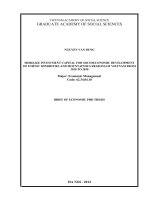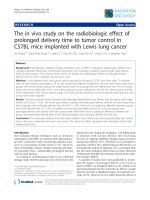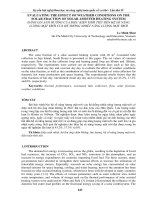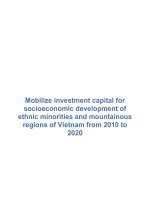Effect of remittances on the real exchange rate the case of vietnam from 2000 to 2020
Bạn đang xem bản rút gọn của tài liệu. Xem và tải ngay bản đầy đủ của tài liệu tại đây (312.83 KB, 31 trang )
FOREIGN TRADE UNIVERSITY
FACULTY OF FINANCE AND
BANKING
******
INTERNATIONAL FINANCE REPORT
Effect of remittances on the real exchange rate the case of
vietnam from 2000 to 2020
Instructor
:
Assoc. Prof. Dr. Mai Thu Hien
Class
:
TCHE414
Group
:
Ha Noi, 2023
1
FOREIGN TRADE UNIVERSITY
FACULTY OF FINANCE AND BANKING
******
INTERNATIONAL FINANCE REPORT
EFFECT OF REMITTANCES ON THE
REAL
EXCHANGE RATE:
THE CASE OF VIETNAM FROM 2000 TO 2020
Instructor
:
Assoc. Prof. Dr. Mai Thu Hien
Class
:
TCHE414
Group
:
Ha Noi, 2023
TABLE OF CONTENTS
LIST OF FIGURES.........................................................................................3
LIST OF TABLES...........................................................................................3
ABSTRACT.....................................................................................................4
CHAPTER 1. INTRODUCTION...................................................................5
1.1. Reason to choose this topic.....................................................................5
1.2. Rationale of the study..............................................................................5
1.3. Literature review.....................................................................................5
1.4. Structure of the research..........................................................................8
CHAPTER 2. THEORETICAL BACKGROUND.......................................9
2.1. Overview of remittance...........................................................................9
2.1.1. Definition..........................................................................................9
2.1.2. Remittance in Vietnam (2010-2020)...............................................10
2.1.3. Pros and cons evaluation.................................................................12
2.2. Overview of the real exchange rate.......................................................17
2.2.1. Definition........................................................................................17
2.2.2. The real exchange rate in Vietnam from 2010 to 2020...................18
CHAPTER 3. EFFECT OF REMITTANCES ON THE REAL
EXCHANGE RATE: THE CASE OF VIETNAM....................................21
3.1. Methodology.........................................................................................21
3.2. Results and evaluation...........................................................................22
3.3. Effect on the real exchange rate in Vietnam.........................................25
CHAPTER 4. RECOMMENDATIONS FOR VIETNAM........................26
CHAPTER 5. CONCLUSION.....................................................................28
REFERENCES..............................................................................................29
2
LIST OF FIGURES
Figure 2.1. Amount of remittances remitted to Vietnam in the period 20102020 (Billion USD).........................................................................................11
Figure 2.2. Real exchange rate of Vietnam from 2010 to 2020......................20
LIST OF TABLES
Table 3.1. Variables description......................................................................22
Table 3.2. Comparison of regression models’ results.....................................23
Table 3.3. Variance Inflation Factor (VIF) result for multicollinearity test....24
3
ABSTRACT
Remittances are a source of external financing for many developing
economies and have been estimated to exceed other types of external funding
such as foreign direct investments (FDIs) and foreign aid over the past two
decades. According to the World Bank (2013) remittances generally reduce
the level and severity of poverty, thus leading to positive effects such as
higher human capital accumulation, improved health and educational
spending, enhancing small business investment, etc.
According to the report on Migration and Development conducted by
the World Bank (WB) and the Global Knowledge Partnership on Migration
and Development (KNOMAD), Vietnam continues to be one of the 10 largest
remittance recipient countries in the world. Recognizing the important
influence of remittances on Vietnam's economy, my team has conducted the
topic "The effect of remittances on foreign exchange rate: The case of
Vietnam".
The study will provide an overview of remittances and exchange rates
as well as analyze the influence of remittances on the exchange rate in the
specific case of Vietnam.
We would like to express our sincere thanks to the subject lecturer,
Associate Professor PhD. Mai Thu Hien for guiding and supporting us
thoroughly and in detail so that we have enough knowledge and apply them to
this essay. Due to the lack of experience as well as the limitations of
knowledge, the essay will certainly inevitably have shortcomings. We look
forward to receiving comments and suggestions from teachers to improve the
essay.
Keywords: Remittance, Real Exchange Rate, Vietnam, Economic Growth.
4
CHAPTER 1. INTRODUCTION
1.1. Reason to choose this topic
Although remittance flows can contribute to economic development, they
may come with costs. Some recent studies show that it is also seen to be
detrimental to the sustainability of the economy due to exertion of pressure on
the real exchange rate. These possible effects of remittance inflows on the
domestic economy raise an important area for research and have in fact
induced the exploration of the relationship between remittances and the real
exchange rate more closely.
Hence, it raises the question of whether remittances have a positive or
negative effect on the real exchange rate.
1.2. Rationale of the study
Based on previous research models and then practice collecting data
from World Development Indicators, our team filtered out Vietnam's data on
real exchange rates, remittances, and trade exchange rates (2010-2020) and
analyzed them through STATA software. The results obtained were
quantified in terms of the impact of remittances on the real exchange rate of
ASEAN countries.
Hence, providing an explanation mechanism and concluding to propose some
recommendations to attract remittances to promote economic growth of
Vietnam.
1.3. Literature review
The empirical research using time series data on the relationship
between remittances and real exchange rates is quite limited. There has been
some amount of work, mainly panel studies that have been carried out over
the last decade. Research evidence shows that remittances have a favorable
effect on a large range of recipient countries' development measures.
However, when flows are out of proportion to the size of the receiving
5
economies, as was the case in several Latin American nations, they can also
bring about a variety of undesirable issues.
Acosta, Lartey, and Mandelman (2008) used an imbalanced panel data
set to investigate the effects of remittances on the real exchange rate for 109
developing and transitional countries from 1990 to 2003. An OLS nation
fixed-effects model and the generalized method of moments (GMM) analysis
found that GDP per capita, the terms of trade index, and GDP growth all
resulted in real exchange rate appreciation, which is statistically significant at
the 10% level. Trade openness, on the other hand, was shown to be
statistically negligible. They discovered that an increase in remittances in
developing nations leads to higher spending, which leads to an increase in the
price of non-tradables. As a result of this, the real exchange rate rises.
Furthermore, an increase in the price of non-tradables causes resource
relocation, which reduces manufacturing productivity.
In a recent research of “Remittances, real exchange rate and the Dutch
disease in Asian developing countries” (2010), Nguyen Phuc Hien, Cao Thi
Hong Vinh, Vu Thi Phuong Mai, Le Thi Kim Xuyen analyze whether or not
Asian developing countries have been affected by Dutch disease. To
investigate the relationship between remittances and the actual effective
exchange rate, they use System Generalized Methods of Moment (S-GMM)
for the linear dynamic panel data (DPD) model from 32 countries from 2006
to 2016. Their findings show that for every 1% increase in remittances per
capita, the real effective exchange rate (REER) of these nations rises by
0.103%, undermining their competitiveness and sustaining the presence of
Dutch disease. Surprisingly, the Dutch sickness only manifests in countries
with a modest ratio of remittances to GDP (less than or equal to 1%).
Meanwhile, remittances cause REER depreciation in countries with a higher
ratio.
6
Hassan and Holmes (2012) examined the long-run link between the real
currency rate and remittances for less developed nations using a panel cointegration approach. According to the findings, remittances cause real
exchange rate appreciation. Furthermore, a panel error correction model was
built, which demonstrated that there is short-run causality from remittances to
the real exchange rate. This finding is also consistent with Combes, Kinda,
and Plane (2011), who used the same technique to examine the effects of
capital flows and exchange rate flexibility on the real exchange rate in
developing economies. The findings reveal both public and private flows are
related with an increase in the real exchange rate.
Some other similar research also indicates that emittances can exert
pressure on the real exchange rate, leading to appreciation of the local
currency (Amuedo-Dorantes and Pozo 2004; Acosta, Lartey, and Mandelman
2007; Lopez, Molina, and Bussolo 2007; Lartey, Mandelman, and Acosta
2008). Simply, this pressure on the real exchange rate is analogous to “Dutch
disease” dynamics: Developing countries receive aggregate inflows from
migrants working abroad, and this increase in financial capital puts upward
pressure on recipient countries’ local currency.
Evidently, most studies that are highlighted here point to the fact that
an increase in remittances results in an appreciation of the real exchange rate.
Several studies, including those mentioned above, provide evidence on
the short-run relationship between remittances and the real exchange rate.
However, very few investigations explore the long-run relationship and
associated short-run dynamics associated with error correction. In this respect,
we contribute to the literature through an investigation of the long-run
relationship between inflow of remittances and real exchange for a panel of
high remittances recipient economies.
7
1.4. Structure of the research
Chapter 1. Introduction
Chapter 2. Theoretical Background
Chapter 3. Effect of remittances on the real exchange rate: The case of
Vietnam
Chapter 4. Recommendations for Vietnam
8
CHAPTER 2. THEORETICAL BACKGROUND
2.1. Overview of remittance
2.1.1. Definition
Remittances are money that are moved from people residing or
working abroad to their relatives in their home country. In some developing
countries, remittances can be the second-highest among income sources,
outstripping international aid. Remittances are contributing to creating
significant additional resources for the country, reducing imbalances in the
balance of payments, improving foreign exchange reserves and reducing
pressure on exchange rate appreciation.
In the Balance of Payments and International Investment Position
Manual (BPM6) remittances are perceived as a cumulative measure building
upon three aggregation levels:
Personal remittances cover the transfer of household funds in cash or
kind and household assets to a non-resident household, usually situated
in the migrant’s home economy (including donations to family, etc.),
but also the net income being generated through employment in other
economies, either as seasonal or border worker, or as resident with nonresident entities (e.g. international institutions domiciled in the
resident’s home economy).
Total remittances additionally include social benefits, which were
acquired by the above-mentioned economic activities of households in
other economies, e.g. pension rights.
Total remittances and transfers to non-profit institutions serving
households (NPISH) additionally include current and capital transfers
of NPISH, such as donations in cash and kind, cross-border
sponsorships, development aid programmes launched by public or
private non-profit organizations (NGOs) in other countries.
9
In simple terms, "remittance is the movement of money from people
living and working abroad to their relatives in their homeland".
Remittances are a relatively stable source of foreign currency, even
during an economic crisis, compared with other sources of financing such as
foreign direct investment and aid money. It helps balance the current account,
strengthens foreign currency reserves, and helps improve the lives of the
recipients, even the GDP of the country where the recipients live.
2.1.2. Remittance in Vietnam (2010-2020)
In the 1980s, Vietnam had fundamental changes in its remittance
policy, thus receiving a large amount of foreign currency inflows from
overseas Vietnamese. On average, a person sends home about 1000 USD a
year. These capital flows have had tremendous impacts not only on
individuals but also on Vietnam's economy and the country's development.
In 2010, Vietnam received 8.26 billion USD and the amount increased
steadily through each year. With this trend, in 2020, the amount of remittance
in Vietnam reached 17.2 billion USD, an increase of about 208%. Even
though in 2019 the global economy had suffered from a serious crisis because
of COVID 19, the amount of remittance did not record a decrease but a slight
growth, from 17 billion USD in 2019 to 17.2 billion USD in 2020.
According to estimates, at present, Vietnam has more than 3 million
people living and working abroad, mainly in developed countries with high
per capita income such as the US, France, UK, Germany, Australia, etc.
2015 is considered a bumper year for remittances when payment
revenue in Ho Chi Minh City area alone has reached more than 5.5 billion
USD, higher than the initial expected figure of 5.2 billion USD.
The 2018 World Bank report said following a 10 percent decline in
2016, Vietnam received approximately 13.8 billion USD in 2017, showing a
year-on-year rise of 16 percent. Ho Chi Minh City remained the biggest
recipient of remittances in Vietnam, with the inflows estimated at 5.2 billion
10
USD, up 4.5 percent against the preceding year. In the first quarter of this
year alone, the city received 1.12 billion USD, an increase of 4.5 percent from
the same period last year.
A sum of 15.9 billion USD in remittances was projected to flow into
Vietnam for the full year, making the Southeast Asian country the tenth
largest remittance receiver — in dollar terms - in the world. Financial and
banking expert Nguyen Tri Hieu said that remittance flow into Vietnam had
stayed on an upward trend from the beginning of this year. This was mainly
because Vietnamese people working abroad believed in the stability of the
economy and saw better investment opportunities in the domestic market, he
said.
Positive signals about the surplus in the trade balance, control of the
inflation index, people's confidence in the tendency to seize the local currency
as well as the appropriate management policy of the State bank are the main
factors. The factor that helps Vietnam's foreign currency market is forecasted
to continue to grow well in the coming years.
Figure 2.1. Amount of remittances remitted to Vietnam in the period 2010-2020 (Billion USD)
Source: Authors compiled from World Bank
11
2.1.3. Pros and cons evaluation
2.1.3.1 Pros
Remittances into our nation have grown greatly over time, which is
encouraging because it demonstrates how significantly Vietnamese living
abroad have contributed to the country's progress. The reason for this rise is
that over the past few years, we have put in place a number of incentive
policies—some of them groundbreaking—to encourage people to be
transparent and trustworthy. Vietnamese overseas and local relations. The
government has published documents over time, including:
Decision No. 170/1999/QD-TT dated August 19, 1999 on encouraging
Vietnamese people to remit money from abroad to home country.
In 1999, the law stipulates that overseas Vietnamese and foreigners
may transfer foreign currency from abroad into Vietnam in the following
three forms:
- Transfer of foreign currency through authorized credit institutions;
- Foreign currency transfer through international postal financial
service providers;
- Individuals bring people into Vietnam.
Recipients of remittances (with income from remittances) are not
required to pay income tax on foreign currencies remitted from abroad. Up to
now, “Receipts from exchange” are still exempt from personal income tax.
(Clause 8, Article 4 on “Exempted incomes’, Law on Personal Income Tax
2007 (amended and supplemented in 2012, 2014)).
These documents' major goal is to make it easier for Vietnamese
expatriates to send money home while protecting the rights of both senders
and recipients. They also aim to broaden available methods of money transfer
to encourage foreign currency remittances to Vietnam from outside. Domestic
beneficiaries are now able to receive foreign currency or Vietnam Dong on
demand, receive remittances in foreign currencies, deposit foreign currency
12
savings at banks, and withdraw both principle and interest thanks to the
aforementioned policies. can use this foreign currency to send money abroad
legally. in foreign currency. Remittances of foreign cash are not subject to a
volume cap and are not taxed. The most recent is Decree 71, which permits
foreigners to purchase real estate.
Furthermore, the present laws governing the administration of foreign
currencies have made it simple and advantageous for Vietnamese living
abroad to bring back foreign currency, such as through border gate customs.
There is no maximum quantity; only the declared amount must be declared to
customs. Non-residents may open a foreign currency deposit account at a
bank for the quantity of foreign money brought in from abroad or foreign
currency transferred from abroad (including overseas Vietnamese and their
relatives). This foreign currency is acceptable in Vietnam for a wide range of
legal transactions.
The second breakthrough is an improvement in the standard of
remittance payments. Across the nation, remittances are made to recipients'
homes. In particular, domestic remittance providers reach out to the leaders of
the community in each locality via word of mouth, through reliable
individuals, to present their products and ask them to introduce them to
friends. Banks and domestic corporations charge only a fifth of what foreign
companies do for the same type of transaction.
Many remittance organizations have taken advantage of alternative
money transfer routes in addition to the traditional cash channel. Dong To
better track the flow of remittances, a remittance provider has implemented an
online transfer program. Previously, the staff had to dig up book information
when the sender wanted to know if the money had reached the receiver or not,
which took a lot of time. The answer is now just a click away, and sending
money to recipients in Vietnam only takes 8–12 hours (for large cities) or 24
hours (for outlying locations).
13
With the implementation of Sacombank's remittance payment service
via card, beneficiaries can now withdraw cash from any ATM. Depositors at
Western Union have the option of using the mobile money transfer service
from 70,000 agent transaction locations across 27 countries, or sending
money from their accounts through the company's 16 correspondent banks.
The organization currently offers online money deposit services in 17 nations
with a sizable expat population, including the US, Canada, UK, Australia, and
Germany.
2.1.3.2 Cons
There is a deficiency at the bank, to start. Vietnamese expatriates who
have lived abroad for a long time or export employees who are sending
money home to their families send remittances to Vietnam. Many people save
this amount of foreign currency, while others choose to sell it on the open
market via a network of gold shops. Because the rate is always higher than at
the bank, doing so is more than just convenient.
This also explains why banks have been steadily raising interest rates
on USD deposits in the past to attract foreign currency and in the hope that
consumers will pay more money to the bank after receiving remittances.
Specifically, in 2010 the USD deposit rate in the money market was adjusted
by banks with a wide margin.
In Tet 2010, USD deposit interest rates of banks in Ho Chi Minh City
increased from 0.1% - 0.3% compared to before and interest rates ranged
from 3.3% - 4.5% for terms under 12 months. Specifically, the international
bank (VIB) has increased the deposit interest rate with USD from 0.43% 0.85% for a year in all terms, the highest level is up to 4.13%/year.
Customers continue to misjudge the adjusted interest rate on foreign
currency deposits, which leads to a lot of people withdrawing foreign money
from banks to store, invest in other areas, or sell foreign currency for
domestic investment. The bank's USD deposits drastically decreased as a
14
result of currency deposits. Due to lower interest rates, exporters choose
borrowing US dollars.
The second is the overabundance in the population. In the context that
the supply of foreign currency is very large in the market today, banks have
difficulty in buying USD. The turnover of remittance payments through
Sacombank in 2009 was USD 850 million, but only 10% of it was sold to the
bank, and very few people sent it back to the bank.
In addition to the reason for the low exchange rate, the fact that many
people do not want to sell USD to banks is also because when they need to
buy foreign currency to serve legitimate needs such as studying abroad,
tourism, medical examination and treatment abroad, they often do not. met by
the bank, or if so, in very small quantities and complicated procedures.
Therefore, besides the habit of buying and selling USD at gold stores, many
people have chosen to store foreign currency.
Thirdly, using remittances is inefficient. Remittances are received in
large amounts, but we don't really take advantage of or use them well for the
economy because, other than covering living expenses, the beneficiaries
haven't put this money directly into production or business. not only to "run
around" in risky investment avenues for business.
With remittance flows coming from labor export sources: the labor
export team is mainly farmers, so the remittances are poured directly into
rural areas, contributing to improving the living standards of this area.
different from remittances from other sources. The problem is that, what is
most lacking in rural areas is business opportunities, so this money will
almost be converted into savings. Even in some places, remittances are not
only economically inefficient, but also cause social problems because farmers
do not know how to use money. Many people, instead of using remittances
for economic purposes, they pour it into personal matters such as gambling,
15
addiction. This type of remittance is not only meant to improve short-term
material life, it is not meaningful. promoter of rural economic growth.
Interest rates on USD deposits in Vietnam are high (about 5%/year)
while deposits in the US have interest rates of about 0.5%/year, leading to the
phenomenon of remittances flowing back home just to save money to enjoy
interest rates. Deposits are not used for investment and economic
development purposes. At the same time, this interest rate difference also
makes it difficult for the management of foreign exchange and the
management of monetary policy of the State Bank. The figure of more than 8
billion USD in 2010 is also the pressure to increase the total means of
payment through the increase in net foreign assets (NFA), making it difficult
for state banks to control the currency.
Thus, bringing out the downside of remittances is just for us to see the
problem more accurately, not completely denying the great role of
remittances in Vietnam's economy. On the contrary, we have, are and will
need to continue to increase remittances. The issue here is that in parallel with
the promotion measures, policies should be implemented to direct or motivate
remittances to invest in the manufacturing sector and human areas such as
education and public health. to create positive long-term development effects
for the country.
16
2.2. Overview of the real exchange rate
2.2.1. Definition
Exchange rate is simply understood as the price of one currency in
terms of another.
There are two ways of expressing exchange rates:
First, the exchange rate is expressed as: 1 unit of local currency to 1
unit of foreign currency: USD/VND = 23000
Second, the exchange rate is expressed as: 1 unit of foreign currency to
1 unit of local currency: VND/USD = 1/23000
In foreign exchange, credit and international trade payments, different
types of exchange rates are formed and serve different purposes. From the
point of view of International Finance, exchange rates are divided into four
categories:
- Nominal exchange rate
- Real exchange rate
- Multilateral nominal exchange rate
- Multilateral real exchange rate
The nominal exchange rate is the rate at which the currency of one
country can be exchanged for that of another.
The real exchange rate is the exchange rate between countries that takes
into account the price level between these countries. Formula of the real
exchange rate is:
𝑒 ×
𝑃∗
𝑅𝐸𝑅 =
If RER equal to 1, it means that goods between two countries have the
same price. If RER is smaller than 1, it means that foreign goods are
relatively cheaper than domestic goods (in other words, the country's currency
appreciates). In contrast, when the RER is bigger than 1, then the foreign
17
goods are relatively more expensive than domestic goods (the country’s
currency depreciates).
Multilateral nominal exchange rate is an exchange rate that measures
the external value or external purchasing power of a currency relative to other
currencies of partner countries. It reflects the average relationship between the
bilateral exchange rate of one currency against another. Formula:
𝑛
𝑁𝐸𝐸𝑅 = ∑ 𝑤𝑗𝑒𝑗
𝑗=1
Based on this formula, it can be concluded that if the NEER increases,
the domestic currency depreciates relative to all other comparable currencies.
Conversely, if the NEER falls, the domestic currency appreciates relative to
all other comparable currencies.
Multilateral real exchange rate equals the multilateral nominal
exchange rate adjusted for inflation, so it reflects the relative purchasing
power of the domestic currency relative to other currencies. Formula:
𝐶𝑃𝐼ư
𝑅𝐸𝐸𝑅 =
𝐶𝑃𝐼𝐷
𝑁𝐸𝐸𝑅 ×
If the REER rises, the domestic currency depreciates against all other
comparable currencies. Conversely, if the REER falls, the domestic currency
appreciates relative to all other comparable currencies.
2.2.2. The real exchange rate in Vietnam from 2010 to 2020.
From 2010 to 2020, the Vietnamese foreign exchange market in general
and the USD/VND exchange rate in particular has experienced an uneven
road.
In the whole period above, the interbank USD/VND exchange rate had
increased by about 24%, from 18,500 VND/USD to 23,070 VND/USD, with
an average price increase of more than 2%/year. However, this number is not
enough to show the ups and downs that the domestic foreign exchange market
has gone through.
18
Exchange rate movements in the past 10 years can be divided into two
completely opposite periods: (i) strong fluctuations in the period 2010-2015;
(ii) become more stable from 2016 to 2020.
In the period 2010-2015, the USD/VND exchange rate increased by an
average of more than 3%/year, especially at times it increased by more than
5%/year (in 2010, 2015). In contrast, since 2016 until now, the USD/VND
exchange rate has become somewhat more stable when the average price
increase margin is only about 0.6%/year.
To achieve this radical change, the USD/VND exchange rate has been
actively supported by fundamental factors, which are:
First, the macroeconomic background has improved significantly.
Vietnam's economic growth has improved in both scale and depth with an
average growth rate of over 6% per year over the past 10 years - one of the
fastest growing countries in the world.
In addition, inflation tends to improve and is under the control of the
Government. Since peaking in 2011, the Government has introduced many
measures and tools both in monetary and fiscal terms to reduce inflation and
bring it to a level below the target level of 4%. The internal stability of the
economy is an important premise for the stability of the domestic exchange
rate, especially from 2015 up to now.
Second, the State Bank's operating policy changes towards flexibility,
closer to the market. In the period before 2016, the State Bank usually
managed the exchange rate by administrative measures, mainly through
adjusting fixed price ceilings and floors.
The introduction of the central exchange rate mechanism since the
beginning of 2016 marked an important turning point for the management
agency in operating the foreign exchange market in a more flexible direction
according to the balance of supply and demand in the market. stabilize
19









